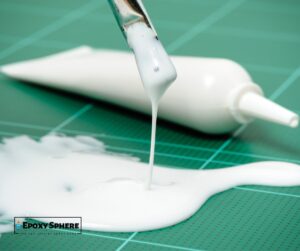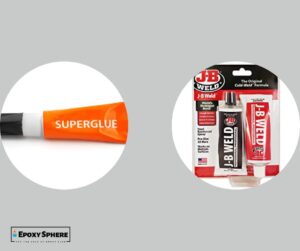
Epoxy is a strong adhesive for bonding surfaces and repairing broken items. But, How to Soften Epoxy Adhesive? However, it is not easy to remove from skin or other surfaces once it has been set. Fortunately, there are several ways to soften hardened epoxy.
Epoxy can be softened with ingredients, and methods found easily at home. The epoxy will lose its hard shell, which makes it easier to remove. In this piece, you’ll learn about how to soften epoxy adhesive:
Use low heat from a heat gun
A safer and more effective way to soften epoxy resin, use a heat gun instead of a blow dryer. Heat guns are designed to deliver concentrated, focused heat that can be applied in small areas at low temperatures.
When used correctly and carefully, they won’t damage the surface of your workpiece or leave any residue behind. These factors make them ideal for working with delicate materials like wood or metal that high-heat tools such as hair dryers and torches might damage.
Here is how to do it:

Wear protective gears
You will need gloves, goggles, and a respirator with gas and vapor cartridges are some protective gear you will need when using a heat gun to soften the epoxy adhesive. You need this because heating epoxy produces fumes that can irritate your eyes, lungs, and mucous membranes.
You can also wear tight-fitting clothes to help protect your skin from the head and any vapor that might want to settle on it.
Use Acetone to soak the surface for at least 1 hour
Using Acetone can help speed up the process, as it acts as a solvent that dissolves the epoxy resin. It can soften the epoxy adhesive that has cured and become rigid, or it can be used on fresh epoxy as a solvent for cleanup.
Depending on the surface your epoxy is attached to, you must soak the area in Acetone for about an hour or more before applying heat to the epoxy.
Focus your heat gun on the epoxy for several minutes
Set your heat gun to a low setting and move it back and forth over the area of interest while heating. Try using an attachment that creates a fan effect to enhance this approach.
If you don’t have access to these attachments yet, you can still use your regular heat gun; work in small strokes rather than letting it stay in one position for minutes. Epoxy will soften after hitting a temperature of over 200°F (93°C).
Scrape off the heated epoxy
To remove epoxy that has been heated, you’ll want to use a plastic scraper. Do not use metal or glass; both will damage the surface you’re trying to remove the epoxy.
Use a solid plastic scraper to remove the epoxy from the surface. If all the epoxies don’t come off, reapply heat over the area and attempt to scrap it off again.
Freezing the Epoxy
If the epoxy has been on your surface for several hours or longer, you can attempt to remove it by freezing it. Freezing the epoxy will cause it to become brittle and easier to scrape off with a scraper.
If you need to remove the epoxy from an extensive area, it may be necessary to repeat this process several times.
Shake your can of refrigerant
Refrigerants are readily available in convenience stores around homes, which makes them easy to buy. Also, the application process is simple and fast.
Always shake the can before you spray it directly on your epoxy. Also, ensure to hold your refrigerant can about 1 foot (30 cm) away from the epoxy you want to spray.
Spray your refrigerant on the epoxy
To soften epoxy adhesive with a refrigerant, you can use a spray bottle, but you get more effective if you add an adjustable nozzle. The spray will rapidly reduce the temperature of anything it touches, freezing your epoxy and making it brittle.
Aim for a thin coating around your hardened epoxy to speed up their freezing process and make them easier to remove from whatever surface they are attached to.
Chip away the brittle epoxy
After spraying your epoxy with a refrigerant, use a scraper or putty knife to chip off as much of it as possible. You can also use a rubber mallet or hammer to hit your frozen epoxy. The epoxy will become so cold that it breaks off easily.
Take care not to damage your surface by putting too much pressure on the epoxy. If it doesn’t break apart easily, try spraying more coolant to freeze the epoxy.
Using chemicals to remove epoxy
You can also use some household chemicals to help you soften epoxy from any surface. However, there are a lot of considerations to make before using chemicals. You need to consider the surface where your epoxy is on, as using harsh chemicals can damage the surface.
Using a paint thinner
If you’re not sure what to use, try a paint thinner. Paint thinners often contain Acetone in suitable concentrations, which is what you need.
If you want to soften up hardened epoxy using a regular paint thinner, here’s how:
- Scrub the hardened epoxy off with an abrasive pad or sandpaper before applying anything else;
- Apply your chosen product directly onto the surface of the hardened epoxy and let it sit for at least an hour;
- Scrap off with a scrapper. Take care not to damage the surface you are working on by applying mild pressure when scrapping.
Use a commercial stripping agent
Use a commercial stripping agent. We may purchase a commercial stripping agent online or at most hardware stores. Look for chemicals that will not damage the surface that the epoxy is stuck on. Either way, ensure enough agents make their way onto the epoxy and wait at least 1 hour before returning to it.
Squirt some on the striping agent and let it sit for an hour, then use an old toothbrush or rag to scrub off the softened epoxy. Also, you will often require a cleaning solution to help remove your stripping agent.
Mix 2-3 tablespoons (50-75 g) of trisodium phosphate into 1 gallon (3.8 L) of hot water and add this mixture over the top of the remaining adhesive on your surface. Let it sit until all traces have been dissolved, and then rinse with clean water.
Removing Epoxy from the Skin
If you’re stuck with epoxy on your skin, here are a few ways to remove it:
- Use vinegar: soak a clean cloth with vinegar and use it to cover the affected area of the skin. Leave for a couple of minutes, allowing the vinegar to soften the epoxy adhesive. After some time, the glue will lift off your skin. Vinegar works on both cured and uncured epoxy adhesives.
- Using petroleum-based solvents: you can rely on solvents such as mineral spirits or Acetone. The process is similar to using vinegar, as described above. However, be careful of these products as they may cause more damage to your skin if left for too long.
- Using Citrus-based waterless hand cleaners: although not readily available in the home, you can get this product from a convenience store nearby. An advantage of using citrus-based hand cleaners is that it’s soft and gentle on your skin. Apply the hand cleaner on your skin before scrubbing. Then rinse off with warm water.
Conclusion
With a little help, you can learn how to soften the epoxy adhesive. However, care has to be taken when trying to soften the adhesive. You must consider the surface and the convenience of the method you choose.

Hi, This is John Davis. After years of working in the construction industry, I decided to create a website that would provide people with information about glue and its exceptional uses. I hope You find it useful






